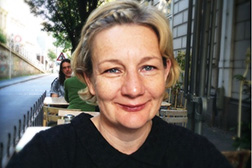Director/Curator Sylt Foundation
http://www.jozi-artlab.co.za/en/index.php
http://www.krsq.de/
http://de.pluspedia.org/wiki/Indra_Wussow
RW.2 ICH SEHE NICHT, WAS ICH NICHT SEHE!
Installed: 19-05-2008
Location | GPS: Kunst:Raum Sylt Quelle, Rantum, Sylt | 54.857815,8.299227
Curator: Indra Wussow
Author: Quotation Heinz von Foerster
Roof Size | Font Size: 2464qm | 3,75m x 57,75m
On Air: –
RW.6 MSAWAWA
Installed: 14-02-2009
Location | GPS: Private home of Niq Mhlongo, Soweto, South Africa | -26.2887431,27.8607648
Curator: Indra Wussow, jozi art:lab Johannesburg
Author: Niq Mhlongo
Roof Size | Font Size: 56qm | 2,5m x 7m
On Air: –
RW.7 ARTMIGRATION
Installed: 14-02-2009
Location | GPS: jozi art:lab, Melville, Johannesburg/South Africa | -26.1751367,28.0108519
Curator: Indra Wussow
Author: Niq Mhlongo
Roof Size | Font Size: 69qm | 1,9m x 12,5m
On Air: –
RW.8 MABONENG
Installed: 09-02-2009
Location | GPS: maboneng precinct former Arts On Main, Johannesburg, South Africa | -26.20449,28.0576329
Curator: Indra Wussow
Author: Niq Mhlongo
Roof Size | Font Size: 272qm | 3m x 22m
On Air: Google Earth 1-2012
Curator on site: Indra Wussow, Sylt Foundation
Exhibition: GLOBALE, ZKM | Center for Art and Media Karlsruhe, Germany
Author: Peter Weibel
On Air: Google Earth 2015
MABONENG – MSAWAWA – ARTMIGRATION
Interview: Niq Mhlongo and Indra Wussow, Soweto 2009
MSAWAWA
REMOTEWORDS: Niq, what does MSAWAWA mean and where does it derives from?
Niq Mhlongo: MSAWAWA is a nickname that has been given to Soweto and it simply means Soweto. What happens here in South Africa: we have a way of calling things – of naming things and places. I don’t know how it originates. For example we call traffic lights ROBOTS here. So we Sowetans call the endearment of Soweto MSAWAWA. When you want to feel like “This is my Soweto” you will call it MSAWAWA.
REMOTEWORDS: So is it also an explanation that is filled with pride?
Niq Mhlongo: Yes, exactly, pride and also in the sense of belonging. So if I go out of Soweto, go out of the township not many people say: Oh you’re from MSAWAWA. So many things here in South Africa are associated with Soweto. In terms of music in terms of dress up people are looking to Soweto. If someone wants to be accepted among people they look into how Soweto is dressed. Even the things we see in TV for example the Kwaito groups are encouraged by Soweto. It’s all about that these people are associated with trends and with modern life.
REMOTEWORDS: So, MSAWAWA on your roof is indicating Soweto from the air like on a map. Secondly MSAWAWA is a message of pride being send from Soweto into the world. Has pride and self consciousness been important for the liberation of South Africa after the terrible years of apartheid?
Niq Mhlongo: Yes, that’s why I like it so much, because it captures almost everything about arts, politics, economics, every sphere of South African life. As I said, Soweto is also a trendsetter in terms of politics. You know about the events of 1976. It happened in Soweto. It is the birthplace of the liberation fight. The rest of the country followed the message of black consciousness. Most of the political leaders are still from Soweto.
REMOTEWORDS: That brings me to our next message. ARTMIGRATION on the roof of the jozi art:lab located in the suburb of Melville. Can you please tell us about the migration of the people from Melville to other parts of the city.
ARTMIGRATION
REMOTEWORDS: Niq, ARTMIGRATION on the roof of the jozi art:lab located in the suburb of Melville. Can you please tell us about the migration of the people from Melville to other parts of the city.
Niq Mhlongo: The reason we thought about ATRMIGRATION was first of all what that house in Melville stands for. It stands for arts and the sharing of arts in two countries: Germany and South Africa. The artists are enriching each other because art migrates from this country to your country and the other way round. Melville itself has a very artistic tradition. You will find many artist, writers and other creative’s there. But – Melville is also part of Sophiatown. It was one of the first multicultural townships. Black, white, colored, no matter what race, people lived together.
REMOTEWORDS: Indra you are the founder and artistic director of jozi art:lab. Why did your foundation supported that work?
Indra Wussow: Jozi art:lab enabled this artwork as a wonderful collaboration of a visual artist and a writer, both working together to explore the spirit of Johannesburg and its different districts and suburbs.
What is the idea of a place, how can you express the idea of a place in a short message that will give passers by and connoisseurs both a clue about what makes this city a special one. It is great that REMOTEWORDS and Niq Mhlongo underwent this experience together – three roofs in different spots of the city – the posh suburb of Melville, the difficult and violent district of Doornfontein and at last the writer’s home in Soweto are the places to send out messages into the world. Migration seems to be the key factor of Johannesburg’s history – anytime since the foundation in 1886 people deliberately moved and were moved, constant change seems to be the motor of the city and its people. For foreigners like me the most interesting point is how people have coped with forceful removal and neglection and the constant search for a place in their city.
Niq Mhlongo: Yes and people from Doornfountain brought their own culture to Melville in 1934. For example Marabi Dance, done by both black and white. Today it is the culture of Kwaito
MABONENG
REMOTEWORDS: Niq, Maboneng is one of the many non-English words that appear in your books “Dog eat Dog“ and “After tears“. Where does “MABONENG“ derives from, what does it mean and why do we find it on a roof in Doornfontain?
Niq Mhlongo: Maboneng literally means “place of light“. With the discovery of gold in 1886, the year Johannesburg was founded, the city attracted migrant workers from all over the world, who sought light and tried to find their fortune in Jozi Maboneng. “Maboneng“ derives originally from the Sotho languages but now is used by all indigenous South African language groups. Doornfontein as one of the first parts of Johannesburg was one of the few culturally mixed areas until 1934, when the people were moved to Sophiatown. The identifying feature of the place was one of cultural diversity and coexistence of different groups. This placed attracted all those people who sought freedom, cultural expression and enlightenment (the Marabi Dance, its language called Tsotsitaal and the shebeens originated from this place and migrated to different areas later).(Tsotsi = villain, shebeen = Beer Bar)
REMOTEWORDS: People where forcefully removed from Doornfountain to Sophiatown?
Niq Mhlongo: Yes at that time people migrated their culture to Melville. But the reason why people were moved out was that they wanted to prospect more gold in Doornfountain. So Jo’burg was a place of Gold. People from Malawi, from Mosambique and from the rural parts of South Africa came to the place of light. So Moboneng used to attract the people with light, the glimmer of gold, electricity and so on. And now the building is going to be a place of light in terms of arts.
REMOTEWORDS: Light is maybe the most important metaphor in the arts. In painting, sculpture, lime light, projection beam…
Niq Mhlongo: And light presents hope.
REMOTEWORDS: That’s right. Furthermore during the discussion of MABONENG we took the important question: Am I in the place of light or do I see it just from outside? We just did this workshop in Kliptown where people still live without electricity.Can you tell us about Kliptown where lots of people are still sitting in the dark.
Niq Mhlongo: You are quite right actually. Light means hope but in Kliptown for example some of the main problems are not solved yet: the problem of infrastructure and lacking development. That is a pitty for Kliptown with all the history. Because Kliptown was the place where our constitution was firstly thought about in 1955. The freedom carta was born there.
REMOTEWORDS: Was’nt Mandela hidden in Kliptown also?
Niq Mhlongo: Yes. So it is very historic but the development is really slow and it is not happening where it matters most. They still use the budget system when coming to sanitation, the houses are still informal and so on. There is much more development in Doornfountain the revival of the city has begun already as we express with MABONENG. But not so in Kliptown. So in terms of light: there is not light in Kliptown.
REMOTEWORDS: Indra, Niq, thanks so much for the great collaboration.

